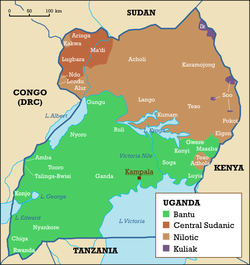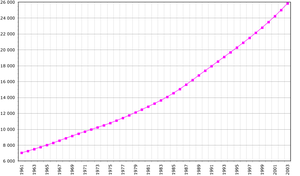- Demographics of Uganda
-
This article is about the demographic features of the population of Uganda, including population density, ethnicity, education level, health of the populace, economic status, religious affiliations and other aspects of the population.
Contents
Ethnic Diversity
See also: Category:Ethnic groups in UgandaAfricans mainly speaking languages of three families—Bantu, Nilotic, and Central Sudanic—constitute most of the population.
Bantu peoples are the most numerous and include the Baganda in the central area (17%), Basoga in the south-eastern area (8%), Banyankole in the south-western area (8%), Bakiga in the most south-western area (8%), Banyoro in the mid-western area (3%), Batooro in the mid-western area (3%), Bagisu in the eastern area, Bahima in the south-western area (2%), Bafumbira in the south-western area (6%), and other much smaller ethnic groups.
Nilotic peoples, mainly in the north, are the next largest, including the Langi, 6%, and the Acholi, 4%. In the northwest are the Lugbara, 4%. The Karamojong, 2%, occupy the considerably drier, largely pastoral territory in the northeast. Europeans, Asians, and Arabs make up about 1% of the population with other groups accounting for the remainder.
More than half of the population is under the age of 15 – more than any other country in the world. Uganda's population is predominantly rural, and its density population highest in the southern regions.
South Asians and Arabs
See also: Indian diaspora in East AfricaDuring the Uganda Protectorate period, the British colonialists used South Asian immigrants as intermediaries. Following independence they constituted the largest non-indigenous ethnic group in Uganda, at around 80,000 people, and they dominated trade, industry, and the professions. This caused resentment among the Black majority, which was exploited by post-Independence leaders. After Idi Amin came to power in 1971, he declared "economic war" on the Indians, culminating in the Expulsion of Asians in Uganda in 1972. Since Amin's overthrow in 1979 some Asians have returned. There are about 12,000 in Uganda today, nearly all in the capital Kampala.
There are also about 3,000 Arabs of various national origins in Uganda.
CIA World Factbook demographic statistics
The following demographic statistics are from the CIA World Factbook, unless otherwise indicated.[1]
Population
32,369,558
note: estimates for this country explicitly take into account the effects of excess mortality due to AIDS; this can result in lower life expectancy, higher infant mortality and death rates, lower population and growth rates, and changes in the distribution of population by age and sex than would otherwise be expected (July 2009 estimate).Age structure
0-14 years: 50% (male 8,152,830; female 8,034,366)
15-64 years: 47.9% (male 7,789,209; female 7,703,143)
65 years and over: 2.1% (male 286,693; female 403,317) (2009 estimate)Population growth rate
2.69% (2009 est.)
Birth rate
48.15 births/1,000 population (2008 estimate)
Death rate
12.32 deaths/1,000 population (2008 estimate)
Net migration rate
-8.83 migrant(s)/1,000 population (2009 estimate)
Sex ratio
at birth: 1.03 male(s)/female
under 15 years: 1.01 male(s)/female
15-64 years: 1.01 male(s)/female
65 years and over: 0.7 male(s)/female
total population: 1.01 male(s)/female (2009 estimate)Infant mortality rate
66.33 deaths/1,000 live births (2011 estimate)
Life expectancy at birth
total population: 52.72 years
male: 51.66 years
female: 53.81 years (2009 estimate)Total fertility rate
- 6.73 children born/woman (2010 estimate)
- 6.77 children born/woman (2009 estimate)
Nationality
noun: Ugandan(s)
adjective: UgandanEthnic groups
Ganda 16.9%, Nkole 9.5%, Soga 8.4%, Kiga 6.9%, Teso 6.4%, Langi 6.1%, Acholi 4.7%, Gisu 4.6%, Lugbara 4.2%, Nyoro 2.7%, other 29.6% (2002 census)
Religions
Roman Catholic 41.9%, Anglican 35.9%, Pentecostal 4.6%, Seventh-day Adventist 1.5%, Muslim 12.1%, Sikhism & other 3.1%, Baha'i 0.3%, None 0.9% (2002 census)
Languages
Main article: Languages of UgandaSwahili (official national language, taught in grade schools, used in courts of law and by most newspapers and some radio broadcasts), Luganda (most widely used of the Niger–Congo languages, preferred for native language publications in the capital and may be taught in school), other Bantu languages, Nilo-Saharan languages, English, Arabic.
References
 Uganda topics
Uganda topicsCommunications · Economy · History · Government · Military · Transport Culture and
religionCricket · Demographics · Education · Football · Healthcare · Languages · LGBT rights · Media · Music · National theatre · Newspapers · Rugby · Wildlife ·
Roman Catholicism · Church of Uganda · Islam · Judaism · Hinduism · Orthodox Christianity
Geography Cities and towns · Districts · Counties · Sub-counties · National parks ·
Kampala · Gulu · Lake Victoria · Lake Albert · Mount ElgonPolitics Constitution · President · Prime Minister · Cabinet · Political parties · Human rights · Terrorism · Foreign relationsEconomy and
infrastructureAgriculture · Central bank · Economy of Uganda · Energy · Fisheries · Forestry · Manufacturing · Ministry of Finance · Transport · Uganda Securities Exchange · Uganda shilling · Water supply · Entebbe Airport · Uganda Railways Corporation
Demographics of Africa Sovereign
states- Algeria
- Angola
- Benin
- Botswana
- Burkina Faso
- Burundi
- Cameroon
- Cape Verde
- Central African Republic
- Chad
- Comoros
- Democratic Republic of the Congo
- Republic of the Congo
- Côte d'Ivoire (Ivory Coast)
- Djibouti
- Egypt
- Equatorial Guinea
- Eritrea
- Ethiopia
- Gabon
- The Gambia
- Ghana
- Guinea
- Guinea-Bissau
- Kenya
- Lesotho
- Liberia
- Libya
- Madagascar
- Malawi
- Mali
- Mauritania
- Mauritius
- Morocco
- Mozambique
- Namibia
- Niger
- Nigeria
- Rwanda
- São Tomé and Príncipe
- Senegal
- Seychelles
- Sierra Leone
- Somalia
- South Africa
- South Sudan
- Sudan
- Swaziland
- Tanzania
- Togo
- Tunisia
- Uganda
- Zambia
- Zimbabwe
States with limited
recognition- Sahrawi Arab Democratic Republic
- Somaliland
Dependencies and
other territories- Canary Islands / Ceuta / Melilla / Plazas de soberanía (Spain)
- Madeira (Portugal)
- Mayotte / Réunion (France)
- Saint Helena / Ascension Island / Tristan da Cunha (United Kingdom)
- Western Sahara
Categories:
Wikimedia Foundation. 2010.


